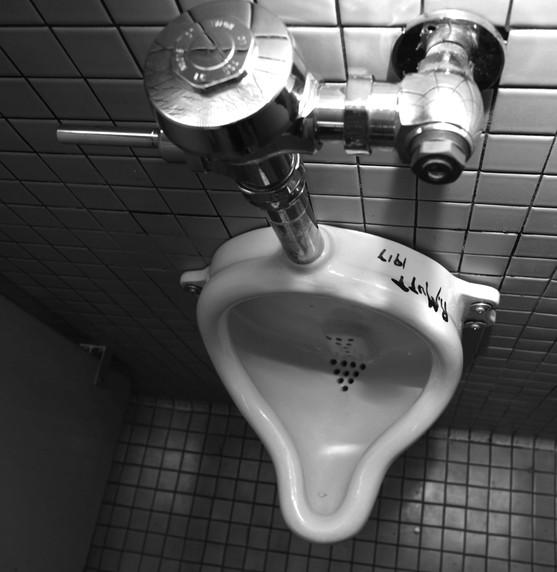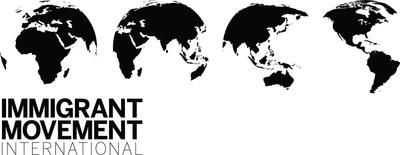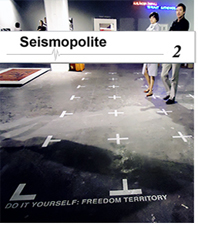December 10, 2011
On the Fallacies of “Useful Art”:
Tania Bruguera’s Immigrant Movement International
Written by Chris Mansour
Tania Bruguera is a performance artist who works on a number of social projects, and who has recently started a center in Queens called the Immigrant Movement International (IMI) to help raise public awareness about the political situation of immigrants. This article accepts this aspect of her work as a kind of social practice. However, its aim is not to discuss this part of this worthwhile endeavor, but an attempt to take it seriously as an artwork. I wish to show that the way she relates her practices to a new, specific art-historical concept, "Arte Útil" exposes her practice to a number of unnecessary obstacles, and may in the worst case create more confusion than freedom.
Tania Bruguera would like to put Duchamp’s “fountain” back on the wall so it can function once again as a quotidian urinal. She claims that it is time to make art “useful,” as opposed to art being simply contemplative or representational. She also conveniently dubs her body of work under the neologism “Arte Útil” (“useful art”).
Interestingly, she claims that “useful art” challenges the philosophical notion that art is an autonomous field – and of course she might be right, depending on how this set of terms is expounded. In doing this, however, Bruguera synonymizes autonomy in art with the anachronistic call from the French in the late 19th century to make art for the sake of art only (l‘art pour l’art), where all art has to do is “remain beautiful”[i]. She then relativizes the truth value of this early modernist paradigm by recourse to a selective art-historical canon that prefigures her own term. As it now stands this premise, as well as the rhetorical shortcut of “usefulness” which it is used to legitimize, lend themselves readily to critique. More fruitfully, however, one might ask if this kind of ad hoc deduction can be read as a sign of the contemporary aporias concerning the politics of aesthetic experience.
Arte Útil and Immigrant Movement International
Arte Útil is meant to intervene in social reality by creating institutions that are pragmatic in nature. These institutions are meant to be a space for participants within the artwork to make proposals and possible solutions to social ills, where the useful art projects merely act as a facilitator for such goals. Examples of “useful art” are, according to Bruguera, performances by the Dada artists, the Russian Constructivists’ objects and architecture that were intergraded into city planning, and various artworks produced under the rubric of institutional critique.[ii]
Bruguera’s concept is rooted in a 20-year-long practice in which she has always, more or less directly, remained faithful to the useful component in the work of art. She has been known for using her artworks as a mode of education, such as reperforming the works of Ana Mendieta in Cuba—where both Bruguera and Mendieta are originally from—in order to introduce the culture of high art from an American context (Mendieta’s work was always made in the context of America). Bruguera also set up the Cátedra Arte de Conducta (Behavior Art School), a pedagogical project equivalent to a master’s program that focuses on producing political art, but which she also considered a work of art in itself. As a whole, Bruguera’s body of works illustrates her intention to prioritize art’s role in making positive social change instead of merely portraying it.
Bruguera envisions her latest socio-political experiment, Immigrant Movement International, as the prototype of Arte Útil. This is a self-initiated institution located in Queens, New York (with funding from Creative Time and The Queens Museum of Art) whose overall intention is to assist in improving the image of immigrants in America (a group that is usually treated with scorn by middle-America[iii]), and to give greater agency to (both legal and illegal) immigrants in learning their rights and building stronger networks amongst themselves. IM International acts as a platform for immigrants to come together and work on a range of social projects: art-making workshops for children, free consultations with immigration lawyers, ESOL classes, community building. Bruguera has showed her support for the #Occupy Everywhere movement, and several protests have been organized at the center, which also produces paraphernalia like shirts, buttons, and bumper stickers that display slogans like “Immigrants are the engine of change” or “Immigrants are smarter than you think.” Bruguera has stated that she would like to see other international centers pop up around the world modeled after the one in Queens.
Art = Ethics?
It is beyond doubt that many of the artists Bruguera cites as early examples of Arte Útil considered their works to carry a useful component, yet their works are termed “useful art” only in hindsight. Cannot Bruguera’s practice – and the rhetorics through which she reasserts the tendency she is coining in the same act – be seen as an exploitation of the very “utility” in such historical examples for her own purposes?

A more problematic consequence of Arte Útil’s failure to seriously address the erroneous dualism between autonomous and socio-politically committed art, is that it effectively hampers the very same social trajectory of making changes which is Bruguera’s sincere intention in the first place. By bluntly dismissing “autonomy,” the Arte Útil liquidates the political function inherent in much “autonomous” art. It appears to succumb, instead, to a combined form of pseudo-art and pseudo-activity.
This bilateral shortcoming is very apparent in the Immigrant Movement International. Considered as a socio-political action, one is for instance puzzled by the center’s lacks of political demands and a specific political ideology. Bruguera claims that “ethics”, without further elaboration, is the driving force behind the IM International and “useful art” in general, and not opening up space for greater political and social freedoms.[iv] In this way she seems to reverse means and ends in the political process, thereby rendering the project’s ambitions even more opaque: it seems to be of lesser importance whether IM International or “useful art” fails to achieve its goals, as long as the heart is in the right place. Unfortunately this position amounts to much of the same gameplay as most bourgeois positions do when they focus their campaigns on creating a positive image of themselves and their constituents by proving how ethical their views are.
One equally puzzles at how Bruguera insists on the IM International being itself a work of art in progress and not simply a means to organize an undeserved community. Considered as an art project, IM International is a process-based rather than object-based project, despite the fact that it is barely, if at all, concerned with aesthetic matters. The project is more akin to the relational aesthetic or social practice art movements that focus on the interrelationships between people and political processes instead of focusing on developing aesthetic sensibilities that work through material problems. As Bruguera noted in an interview, “While I practice that expanded version of aesthetics, my work is about the role of the artist in society and the possibilities for art to be directly involved in social endeavors. In order to get involved in social issues, it is important to truly commit to real action.” Bruguera differently puts her notion of an “expanded version of aesthetics” when she claims that “[useful art is the] transformation of the condition of ‘viewer’ onto one of ‘citizenry.’”
The work of art in the age of anaesthesia
How is direct social “real action” under the aegis of art any more authentic than that of a formal or material decision for an aesthetic object? Do not artworks without an overt practical and/or representational function influence and reflect the practical world, even if indirectly? Paradoxically, Bruguera appears to reify the bifurcation between art and social life—and consequently the separation between aesthetics and politics—by collapsing the two modalities together through the claim that her “useful art” is more real than art itself. In this state of imagination, her understanding is premised on the ideology that art has no effect outside of itself like a closed circuit, as if all art and aesthetic objects (or processes) exist in a vacuum. She ends up reinforcing the fantasy that much art is somehow ethereally posited outside or beyond lived reality without the faintest realization that the two are parasitic to each other, even if art often self-consciously draws its line of separation. Thus, when Bruguera cannot recognize how Picasso’s Guernica is political itself[v] (irregardless of whether or not we consider it to embody good politics), she is admitting how she can no longer digest the impact that an aesthetic experience can bring to an individual and collective body—which is also a form of political experience, no matter how convoluted and ungraspable it might seem. Consequently, right from the get-go, the IM International ends up aestheticizing politics and renders both artistic and political struggles impotent because of its own faulty self-understanding.
Beyond a critique of Bruguera’s projects on their own terms, one might perhaps more fruitfully understand her arguments as symptomatic of a time when we can only experience the world anaesthetically, as Susan Buck-Morss aptly put it,[vi] and when aesthetic experience is drained of relevance to the point of absence. It is precisely when “useful art” claims to have succeeded in merging art and social life, that aesthetic experience is trampled over and devalued. Instead of art becoming useful, and usefulness becoming art, each act as a surrogate to the other under the “useful art” guise. This, however, demonstrates exactly why art needs to deem itself as “autonomous” in the sense of being differentiated from the cacophony of lived experience in order to show what is possible beyond the humdrum existence of the status quo in social life. By contrast to Arte Útil, which seems to entrench itself steadily in a utilization and imagination of what already preexists, such a definition of autonomy retains art’s politically utopian potential, and opens the imagination to new languages and means of critique, hence also expanding upon possible innovative solutions, even if negatively.
In this sense of autonomy, art can be called useful exactly in its uselessness, and thus emphasizing the autonomy of art is a socio-political gesture, even if the work may not function in the public or cannot be explicitly instrumentalized for something. The category of “useful art,” however, fails to recognize this feature in art because of its improvident emphasis on immediate pragmatic results.
Beyond judgment – and reality TV?
The charge of the IM International being a pseudo-artwork, which was claimed at the beginning of this essay, might not be entirely accurate since art history has proved that anything or any project can be deemed as art (i.e., Duchamp’s Fountain). To follow a more traditional mode of thought, it might be more appropriate to judge whether the IM International is a good work of art aesthetically or not. But since this project does not lend itself to be judged aesthetically, and it seeks to address other social problems outside the traditional framework of art—to the point where aesthetics have been casted aside in favor of making ethical judgments—it becomes difficult, if not impossible, to reach a conclusive aesthetic judgment without confusing problems arising. The ill-defined grey area that IM International hovers in—it is called art in some respects, but other respects it is a social organization—is why its status as pseudo-art might be the most appropriate for the time being: the justification for the IM International’s existence will always slide either to being an art project when it is judged on the basis of functioning as a socially useful project, or slide to being a socially useful project when judged on the criteria of art. The IM International is pseudo-art precisely because it is setup to escape critique. In other words, the category of “useful art” does not illuminate the internal contractions of what makes art art, but botches them instead. [vii] The same can be said about the IM International as a socio-political institution.
The reasons listed above are also why IM International also falls victim to being pseudo-activity: because the whole experience it brings for the participants and the public fail to clarify what needs to be done in a pragmatic sense, much less how it functions as an artwork. Pointing even more directly to its pseudo-active character, accompanying the IM International is a yearlong performance by Bruguera where she is living like an illegal immigrant. As The New York Times reported, she is “sharing a tiny apartment in Corona, Queens, with five illegal immigrants and their six children, including a newborn, while scraping by on the minimum wage, without health insurance.”[viii] Not only does this action trivialize the plight of illegal immigrants in the US, but this action fails to raise Bruguera’s—or anyone else’s—political consciousness about immigration or human rights that increases the possibility of freedom. The equivalent to such an action would be to allow oneself to submit oneself to be fully exploited or oppressed to understand how society is exploitive and oppressive. The simulation that Bruguera puts herself through functions much like a reality T.V. game show where her consciousness of immigrants’ suffering will become just as informed as a reality T.V. show’s challenger.
A useful lesson on the edge of art
If the IM International, and Arte Útil in general, is to have any success beyond marginally improving the life of a few immigrants or spreading a convoluted message to the world, greater reflection is needed in the areas it attempts to tackle. Its open-ended and confused character, even though it is its greatest weakness, might also be its greatest strength; since the IM International is still in its experimental phase, there is room for it to develop into a more interesting art project or socio-political movement. However, in its current configuration, and first and foremost due to its self-presentation as an art-historical and aesthetic paradigm, it is bound for failure in such a way that it will only lead to greater confusion than freedom.
CHRIS MANSOUR is a writer, curator and artist based in San Francisco.
[i] In a recent interview with Robert Pippin, Pippin claimed that there are two definitions behind art’s autonomy: one being the “art for art’s sake” notion spelled out above; the other definition, which he considered more provocative and complicated, stems from the German philosophic tradition starting with Kant. As Pippin said,
Kant was the one who started the idea of conceiving of art in a completely new way, not connected to politics, religion, or even philosophy. Art was a distinct modality of making sense[…] Art, precisely because it is a mode of non-discursive intelligibility, which does not consist in propositions, arguments, and syllogisms, nonetheless makes sense of ourselves in a way that actually resonates with what is now coming onto the scene as more important than the conscious deliberative capacities of individual subjects.
See Robert Pippin, “After Hegel: An interview with Robert Pippin,” Platypus Review #36 (June 2011), available online at <http://platypus1917.org/2011/06/01/after-hegel-an-interview-with-robert-pippin/>. Bruguera’s enmity towards the autonomy of art fails to take into account the notion exemplified in the Kantian schema, and only attacks the (arguably less complex) notion of l‘art pour l’art.
[ii] A list of “useful art” projects can also be accessed here.
[iii] The hatred towards immigrants is due either to flat-out racism, or the misrecognition that all the “immigrants” are the root cause for economic hardships in the country, as they are often blamed for taking the jobs away from authentic Americans who were there “first.” Usually, however, the two forms of reasoning go hand-in-hand.
[iv] “But what motivates me most are ethics. There is an aesthetic dimension of ethics that for me is very clear and works in very specific ways (maybe due to my socialist education?). Ethics emotionally affects me more than any artwork.” Tania Bruguera, “5 Questions (for Contemporary Practice) with Tania Bruguera,”Art 21 (14 April 2011), <http://blog.art21.org/2011/04/14/5-questions-for-contemporary-practice-with-tania-bruguera/>.
[v] "I do not believe in the autonomy of art. I never bought the impact of Guernica, nor the potential people saw in it to call for peace. I might be too cynical about it. I think people project too much in art, too much sublimation about the humanism behind it.” Tania Bruguera, “5 Questions (for Contemporary Practice) with Tania Bruguera,” Art 21 (14 April 2011) <http://blog.art21.org/2011/04/14/5-questions-for-contemporary-practice-with-tania-bruguera/>.
[vi] “In this situation of “crisis in perception,” it is no longer a question of educating the crude ear to hear music, but of giving it back hearing. It is no longer a question of training the eye to see beauty, but of restoring “perceptibility.” See Susan Buck-Morss, “Aesthetics and Anaesthetics: Walter Benjamin’s Artwork Essay Reconsidered,” October 62 (Autumn, 1992): 18.
[vii] As T.J. Clark claims, art since the origins of modernism can be broadly described as always negating itself and the society it was born in. See T.J. Clark, “Clement Greenberg’s Theory of Art,” Critical Inquiry (Vol. 9, No. 1, Sept., 1982), available online at <http://www.jstor.org/pss/1343277>. See also Adorno’s aesthetic theory, where he claims that the anti-art impulse is intrinsic to art; in other words, art always has a relationship to its “Other.” See Theodore Adorno, Aesthetic Theory, trans. Robert Hullot-Kentor (New York: Continuum 2004).
[viii] Sam Dolnick, “An Artist’s Performance: A Year as a Poor Immigrant,” New York Times (18 May 2011). Available online at <http://www.nytimes.com/2011/05/19/nyregion/as-art-tania-bruguera-lives-like-a-poor-immigrant.html?pagewanted=all>.









